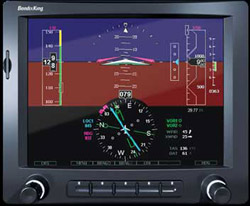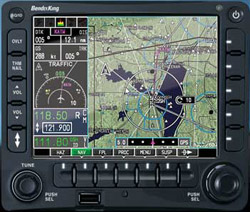Honeywell Bendix/King’s new KFD 840 primary flight display (PFD) and KSN 770 multifunction display (MFD) are undergoing final stages of flight testing in the company’s Cessna 182.

Honeywell Bendix/King KFD 840
Plans are to bring the $16,995 KFD 840 to market in the early second quarter of 2009; the $13,995 KSN 770 should follow in mid-2009. Both units are designed as replacement units for the conventional “six pack” panels in a wide range of FAR Part 23 piston aircraft. The KFD 840 will come with an integrated air data attitude heading reference system (ADAHRS), vertical tape symbology, weight and balance functionality, and compatibility with S-Tec, Century, Bendix/King’s KAP and KFC series of autopilots, among other brands. An optional battery backup will also be offered. The unit has an 8.4-inch diagonal active matrix liquid crystal display, and Honeywell says synthetic vision will soon be added.

Honeywell Bendix/King KSN770
The KSN 770 has the same display size as the KFD 840 and features a WAAS LPV-capable GPS receiver, graphical flight planning, and compatibility with enhanced ground proximity warning systems (EGPWS), traffic alert and collision avoidance systems (TCAS), and XM WX datalink weather. Options include electronic charts, a weather radar interface, terrain awareness warning systems (TAWS), and a 16-watt comm radio upgrade. The unit’s operating logic—especially in the flight-planning mode, closely resembles that of Honeywell’s Apex avionics suite, now featured in the Pilatus PC-12NG.
In the business jet arena, Honeywell reports that an advanced file graphic server (AFGS) will be added to its retrofit CDSR (control display system for retrofit). This will let owners of CDSRs installed in such business jets as the Gulfstreams II and III, Falcon 900s, Challenger 600s, Hawker 800s and 1000s, and Citations III and V add electronic chart, moving map, and datalink weather capabilities. The AFGS runs $75,000 to $80,000 plus installation costs.
Honeywell will also be offering LCD replacements for CRT-equipped airplanes in 2009. One display, the eight-by-eight-inch DU 885, is designed for such airplanes as the Gulfstream IV, which has Honeywell’s SPZ 8000 avionics suite. The eight-by-seven-inch DU 875 display system is for airplanes having Honeywell’s Primus 1000 and 2000 avionics suites. Honeywell boasts that swapping out CRTs for the new LCDs doubles reliability, adds graphics capability, and improves resale value. Both upgrades will be performed at Gulfstream service centers. Down time is projected as 10 days.
In the third quarter of 2009, a new stabilized approach monitor (SAM) will be available from Honeywell. Like Honeywell’s runway awareness and advisory system (RAAS), the SAM is set up to prevent runway incursion and collision problems, but of a different kind. The SAM is a $25,000 software enhancement to Honeywell’s Mark V and VII EGPWS systems, and it cues on glide slope information to warn of approaches that are too high or low, and too fast or slow. Configuration warnings for gear and flap deployment are also provided. If an approach isn’t stabilized at decision height, a warning—“unstable, unstable” is issued. The SAM database will have 8,000 airports, 25 percent of which are also covered by RAAS.



